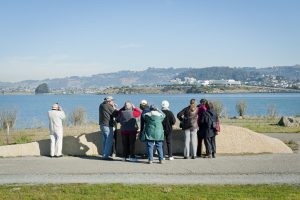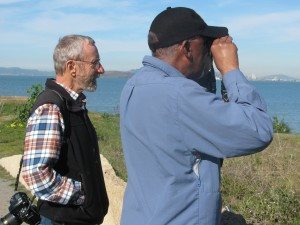Avian ambassadors in Berkeley
By Frances Dupont
A Golden Gate Bird Alliance docent hikes a half mile to the northeast corner of Cesar Chavez Park, carrying binoculars, camera, brochures, data sheets and a spotting scope. She sets up the scope next to the trail and aims it at a small speckled lump that blends in with the dry grass beside a ground-squirrel hole. Then she greets a passerby and asks if he would like to see an owl. He peers through the scope and sees a pair of bright yellow eyes looking back at him, and says something like, “Oh my gosh.” Taking his eye away from the scope, he looks out across the grass and asks, “Where is it?”
The Chavez Park Burrowing Owls are a delightful lesson in camouflage. This helps to explain how they manage to survive along a busy park trail. The GGBA docents call attention to those owls that are within the area cordoned off by a protective art installation, so that the public may understand why the area is protected. These yellow-eyed ambassadors help spread the word that even a busy public park is shared with a wide variety of birds and other creatures.

Each year several Burrowing Owls spend the winter at Cesar Chavez Park, at the end of University Avenue, next to the City of Berkeley Marina. This former dump site was covered and then turned into a park in 1991. Twenty-one years later, it is heavily used by walkers, dog-walkers, joggers, cyclists and, surprisingly, wildlife. Up to ten burrowing owls reportedly wintered in the park once, and five owls were seen in the winter of 2011-2012.
Burrowing Owls are one of the few birds that live in a hole in the ground, and they are the only ground-dwelling owl. They are capable of digging their own burrows in soft soil, but generally use holes dug by ground squirrels. They were once a common grassland bird, but their habitat has been greatly diminished by agriculture and housing. Currently they breed in the Central Valley, but the owls that winter in Chavez Park may have raised their young as far away as Idaho. Here in Berkeley, the ground squirrels and owls have been able to create comfortable living quarters along the stone rip-rap that separates the landfill from the bay. Many park regulars make a habit of looking for the owls when they walk the perimeter trail between October and March. However, other park users have no idea the owls are there and need to be protected.

In 2008, the den of one of the owls was dug up by an off-leash dog and the owl disappeared. Golden Gate Bird Alliance volunteers were concerned that the owls were being disturbed and might abandon the area. They worked with the City of Berkeley to erect a temporary fence along the northeast section of the park, and put up informational signs. In 2009, the Chavez Park Burrowing Owl Docent program was established, under the aegis of GGBA and with the support of the Shorebird Nature Center and the Berkeley Marina. At the same time, the Berkeley Civic Arts Commission began working on plans for an art installation in the same area. A Burrowing Owl volunteer worked with the commission to be sure that the project did not disturb the owls, and in 2012 a protective wall was installed that echoes the outline of the Berkeley Hills.

This September the Burrowing Owl Docent Program will begin its fourth season. We’re looking for new docents. If you’re interested, sign up for our docent training on Saturday Sept. 22nd! (Details below.) No experience is needed — just a love of wildlife and a desire to share that love with others.
Last year, between October 1, 2011 and March 30, 2012, a group of twelve docents visited the park at least 131 times. During defined periods of time, the docents counted the number of passersby, the number of visitors that that stopped to observe the owls, and the number of on- and off-leash dogs.
Over the course of 125 survey hours they recorded 4,932 passersby, and interacted with at least 1,169 of them. The docents counted 646 dogs on leash and 130 off-leash dogs, and noted any disturbances to the owls as a result of off-leash dogs.
Although we would love to see 100 percent of the dogs on leash, this compliance rate of over 83 percent is exceptional. It reflects the degree to which Berkeley dog owners understand the reasons for the leash requirements in the park, and, hopefully, the educational efforts of the docents. Although the docents gently remind dog owners of the leash laws, they are careful to avoid unpleasant encounters with belligerent dog owners. Docents have reported a number of incidents where other dog owners and park visitors have reprimanded the owner of an out-of control dog they thought might threaten the owls.
Cesar Chavez Park is a former dump that is now appreciated by humans, dogs and birds, and the efforts of the Chavez Park Burrowing Owl Docents may be helping them all coexist. We hope that each visitor has the opportunity to discover how fascinating birds can be, especially when viewed through a good lens.
———————————–
Golden Gate Bird Alliance will host a free training session for Burrowing Owl docents on Saturday Sept. 22nd, from 9 a.m. until 4 p.m. at the Shorebird Nature Center, 160 University Avenue in Berkeley. All are welcome — no experience needed — but an RSVP is required to attend. Volunteers should be willing to spend one to two hours per visit, at least twice a month, from October through March. If you’d like to attend, please RSVP to nweeden@goldengatebirdalliance.org or call 510-301-0570.
——————————-
Frances Dupont is is a retired biologist and volunteer who works with several local organizations that serve to increase appreciation and conservation of the unique San Francisco Bay urban wilderness interface. She has served as a docent with Golden Gate Bird Alliance’s Cesar Chavez Park Burrowing Owl program for three years.

